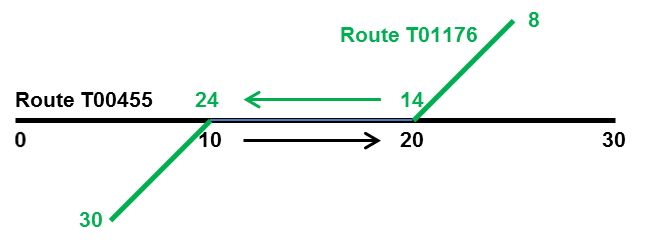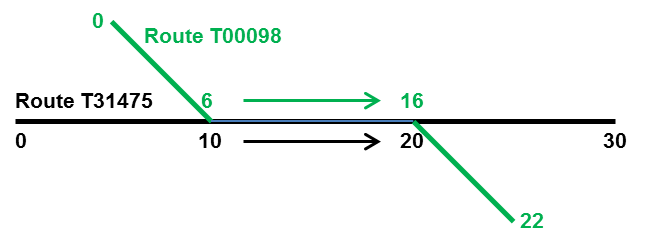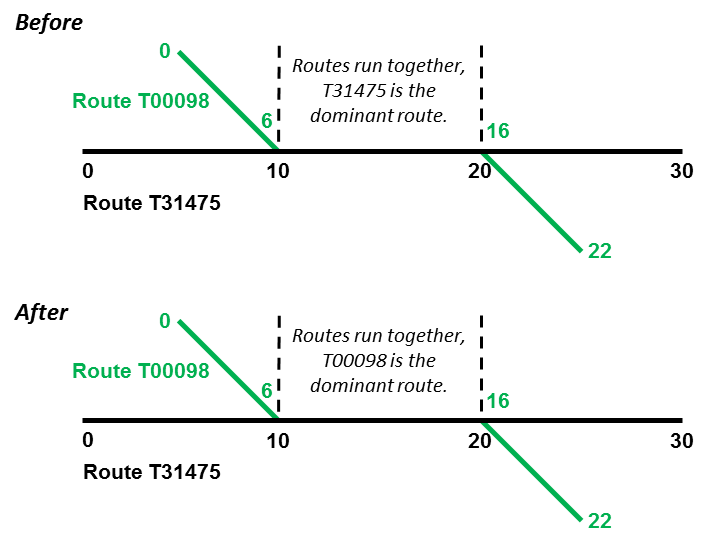Standard transactions are those transactions that modify the road network without deleting event data associated with modified road segments. The available standard transactions are described in greater detail in the following sections:
| Table of Contents | ||
|---|---|---|
|
Add a Route
Description
The Add a Route network transaction adds a new route to the road network. Before adding the new route, the system checks whether the entered route exists and, if so, returns an error. If the system does not find an existing route with the entered name, it adds the new route to the network with the entered start and end measurement values.
When you select this type of transaction, the system displays the following fields:
Example
A new, 10-mile route called T00002 needs to be added to the network. The start of this route is 0 ("start measure") and the end of the route is 10 ("end measure"). These are the input values you would enter in the fields that were displayed when you selected this type of transaction.
Add Asphalt to the End of a Route
Description
This transaction extends a route by adding a new length of roadway to the end of the existing road section. It also assigns the surface type to be asphalt. When you select this type, the system displays the following input fields in the lower part of the window:
Example
An agency extends route T00001 by five miles using asphalt as the surface layer. The inputs for the transaction would be as shown in the example above. Graphically, this would be represented as shown below:
Add Asphalt to the Start of a Route
Description
This transaction extends a route by adding a new length of roadway to the beginning of the existing road section. It also assigns the surface type to be asphalt. When you select this type, the system displays the following input fields in the lower part of the window:
Example
An agency adds four miles of asphalt pavement to the beginning of route T00403. The inputs for the transaction would be as shown in the example above. Graphically, this would be represented as shown below:
Add Second Route to End of Route
Description
This transaction combines two routes into a single route. The second route (labeled as "route to add" in the Network Transactions window) is added to the end of the first route (labeled as "main route" in the Network Transactions window). The second route cannot partially overlay the first route and after being combined with the first route is no longer part of the network.
When you select this type of network transaction, the system displays the following input fields in the lower part of the window:
Example
A road network contains two routes: T01402 and T04403. Route T01402 is the main route. Route T04403 will be added to the end of the main route. (Route T04403 will no longer be part of the road network.) Graphically, the result of this transaction would appear as shown below:
Add Second Route to Start of Route
Description
This transaction combines two routes into a single route. The second route (labeled as "route to add" in the Network Transactions window) is added to the beginning of the first route (labeled as "main route" in the Network Transactions window). You may also set a new beginning value for the combined route by entering it in the "new start on main route" field.
When you select this type of network transaction, the system displays the following input fields in the lower part of the window:
Example
A road network contains two routes: T01402 and T04403. Route T01402 is the main route. Route T04403 will be added to the main route starting at a point four miles from the start of the main route. (Route T04403 will no longer be part of the road network.) Graphically, the result of this transaction would appear as shown below:
Create a New Dom/Sub Record (Opposite Direction)
Description
This transaction creates a dominant and subordinate route relation between two routes that go in opposite directions as shown in the example below. In this example, route T00455 is the dominant route and is measured from left to right. The subordinate route T01176 is, however, measured in the opposite direction (from right to left).
When you select this type of transaction, the system displays the following input fields in the lower part of the window:
Example
As described in the previous section and shown in the input fields above, route T00455 is the dominant route and route T00176 is the subordinate route. The two routes join at mile post 10 as measured along the dominant route ("start dominant") and separate at mile post 14 as measured along the subordinate route ("end subordinate"). The two routes travel together for 10 miles ("length of dom/sub piece").
Create a New Dom/Sub Record (Same Direction)
Description
This transaction creates a dominant and subordinate route relation between two routes that go in the same direction as shown in the example below. In this example, route T31475 is the dominant route and is measured from left to right – as is the subordinate route T00098.
When you select this type of transaction, the system displays the following input fields in the lower part of the window:
Example
As described in the previous section, route T31475 is the dominant route and route T00098 is the subordinate route. The two routes join at mile post 10 as measured along the dominant route ("start dominant") and mile post 6 as measured along the subordinate route ("start subordinate"). The two routes travel together for 10 miles ("length of dom/sub piece").
Delete Dom/Sub Record
Description
This transaction severs the dominant/subordinate relationship between two routes for all or a portion of the road section over which they travel together. Once severed, the routes are entirely independent of each other.
When you select this type of transaction, the system displays the following fields at the bottom of the Network Transactions window:
Example
In the previous section, routes T31475 and T00098 were put into a dominant/subordinate relationship from mile point 10 to mile point 20 as measured along the dominant route. If you would like to sever the dominant/subordinate relationship for mile points 12 to 18, you would enter the values shown in the example above.
After the transaction runs, routes T31475 and T00098 would be independent for mile points 12 to 18. This means that events would be logged only on the dominant record for mile points 10 to 12; logged on either the dominant or subordinate record (as appropriate) for mile points 12 to 18; and then only on the dominant record for mile points 18 to 20.
Delete Gap at a Mile Point
Description
This transaction deletes a gap in a route. The deletion results in an extension of the length of the road section.
When you select this type of transaction, the system displays the following input fields at the bottom of the network window:
Example
Route T00001 runs continuously from mile point 0 to mile point 2 and then continuously again from mile point 4 to mile point 10 (there is a gap from mile point 2 to mile point 4) as shown in the graphic below. After running this transaction, the system will have removed the two-mile gap, resulting in a new road length of 10 miles.
Re-align End with Re-naming of Old Roadbed
Description
This transaction adds a new section of roadway onto the end of a route and re-arranges the mile points of the route accordingly. The old road section is retained in the network, but is assigned a new route name.
When you select this type of transaction, the system displays the following fields at the bottom of the Network Transactions window:
Example
Route T00035 currently runs from mile point 0 to mile point 9. The end of this route from mile point 3 ("realignment point") onwards was recently re-aligned, with eight miles added to the length of the roadway ("length of new pavement"). The old section of the route (that is, the section from mile point 3 to mile point 9) will remain part of the network, but will have a new route name – T09081 ("name for the old piece of pavement"). Graphically, the result of this transaction is as shown in the picture below:
Re-align Middle with Re-naming of Old Roadbed
Description
This transaction adds a new section of roadway within a route and re-arranges the mile points accordingly. The old section is not deleted, but rather is assigned a new route name.
When you select this type of transaction, the system displays the following input fields at the bottom of the Network Transactions window:
Example
Within route T00001 from mile point 2 ("start realignment") to mile point 4 ("end realignment"), the roadway was re-aligned. The length of the re-aligned roadway was five miles ("length of new pavement"). The old section of the roadway remains part of the network, but is now called route T00002. Graphically, the result of this transaction is shown below:
Re-align Start with Re-naming of Old Roadbed
Description
This transaction adds a new section of roadway onto the beginning of a route and re-arranges the mile points of the route accordingly. The old road section is retained in the network, but is assigned a new route name.
When you select this type of transaction, the system displays the following fields at the bottom of the Network Transactions window:
Example
Route T00675 currently runs from mile point 0 to mile point 12. Between the start of this route and mile point 4 ("realignment point") was recently re-aligned, with five miles added to the length of the roadway ("length of new pavement"). The old section of the route (that is, the section from mile point 0 to mile point 4) will remain part of the network, but will have a new route name – T00675 ("name for the old piece of pavement"). Graphically, the result of this transaction is as shown in the picture below:
Re-name a Route
Description
This transaction re-names an existing route. The old name is replaced by the new name throughout the system.
When you select this type of transaction, the system displays the following fields at the bottom of the Network Transactions window:
Example
Route T00675 is now route T09870. You would enter these two route names in the input fields as shown above. After the transaction runs, the new name will be used throughout the system.
Re-name the Beginning of a Route
Description
This transaction splits an existing route at a given mile point into two routes. The first portion (that is, the beginning portion) of the route is re-named. The second portion of the route will have the existing route name with the beginning mile point being the mile point at which the split occurred.
When you select this type of transaction, the system displays the following fields at the bottom of the Network Transactions window:
Example
Route T01735 currently runs for 25 miles from mile point 6 to mile point 31. To split the route into two routes at mile point 9 (with the section preceding mile point 9 re-named as route T09998), you would enter the values shown in the input fields above. The result of running this transaction is shown in the graphic below.
Re-name the End of a Route
Description
This transaction splits an existing route at a given mile point into two routes. The first portion of the route will continue to have the same route name with the ending mile point being the mile point at which the routes were split. The second portion of the route (that is the end portion) is given a new route name with the beginning mile point being the mile point at which the routes were split.
When you select this type of transaction, the system displays the following fields at the bottom of the Network Transactions window:
Example
Route T01115 currently runs for 23 miles from mile point 5 to mile point 28. To split the route into two routes at mile point 14 (with the section following mile point 14 re-named as route T00076), you would enter the values shown in the input fields above. The result of running this transaction is shown in the graphic below.
Re-scaling
Description
This transaction extends or deletes the end of a route (based on entered values) and assigns new measurement values to the entire length of the extended or truncated route.
When you select this type of transaction, the system displays the following fields at the bottom of the Network Transactions window:
Example
| Wiki Markup |
|---|
Route T00001 currently runs from mile point 0 to mile point 10. The section between mile point 2 ("start realignment") and mile point 4 ("end realignment") was re-aligned, resulting in an increase of one mile (that is, mile point 4 became mile point 5 \["new end realignment"\]). To change the system to reflect this re-alignment, you would enter the values in the input fields shown above. Graphically, the result of this transaction is shown below.
!worddavad87b46b024006c987b293c1571b1336.png|height=186,width=478! |
Reverse a Route
Description
This transaction reverses the measurement values for a route (that is, the current beginning becomes the new end). The length of the route is not affected.
When you select this type of transaction, the system displays the following fields at the bottom of the Network Transactions window:
Example
Route T01115 currently runs from mile point 10 on the western end of the route to mile point 20 on the eastern end. To reverse the mile points for this route, you would enter the route number in the input field shown above. Graphically, the result of this transaction is as shown below.
Shift a Route
Description
This transaction modifies all mile points along a route by a user-entered amount. Only the mile points change; the length of the route remains constant.
When you select this type of transaction, the system displays the following fields at the bottom of the Network Transactions window:
Example
You want to add two miles to each of the mile points along route T00001. To accomplish this, you would enter the values shown in the input fields above. Graphically, the result of this transaction is as shown below.
Trade Dominance
Description
When a dominant/subordinate relationship exists between two routes, this transaction reverses the relationship (that is, the dominant route becomes the subordinate route and the subordinate route becomes the dominant route) for all or a portion of the road section over which the two routes run.
When you select this type of transaction, the system displays the following fields at the bottom of the Network Transactions window:
Example
Currently, routes T31475 and T00098 run together from mile point 10 to mile point 20 as measured along route T31475. The dominant route is T31475, while route T00098 is the subordinate route. After running the transaction, this relationship is reversed from mile point 10 ("start on dominant route") to mile point 20 ("end on dominant route") as shown in the graphic below.

































